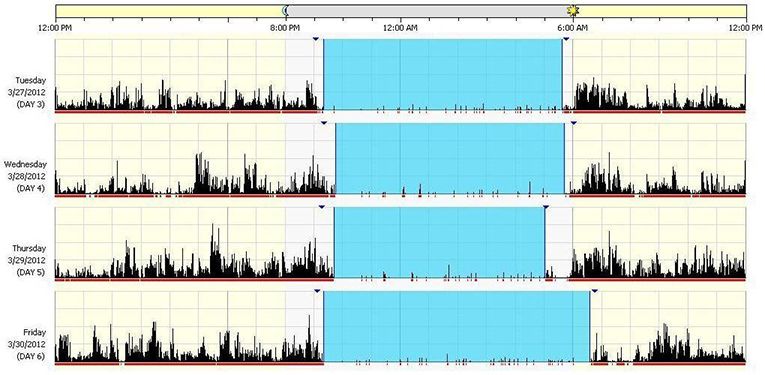Apple Watch OS9's New Sleep Stages: How Good Is It and What It Means for Your Sleep
Sleep experts review Apple Watch's sleep stages tracking feature in the new WatchOS9. How good is the data and what you should know

Earlier this month, at Apple’s 2022 Worldwide Developers Conference, the company announced improvements to the Apple Watch OS 9, including the addition of sleep stages to the smartwatch’s Sleep app and tracking capabilities.
This news sounds great, but if you have an Apple Watch you may be wondering, how good is it at sleep quality assessment? What information will I gain about my sleep, including my deep sleep, from these updates, and how good is the sleep data?
The sleep experts from the Zest team delved into the details, and here’s where we landed.
WatchOS9 adds sleep stages
Previous versions of the Apple Watch's sleep tracking only included estimates of your time in bed and when you were asleep vs. awake, with few details or other data to help you understand your sleep. The newest updates will, according to Apple, improve the Apple Watch's sleep tracking accuracy by further breaking down how much time you spend in 4 different sleep stages (which they’ve termed Awake, REM, Core, and Deep sleep).

Traditionally in sleep medicine, sleep stages are REM and Non-REM (non rapid eye movement, or NREM), with the latter divided into three sub-stages (NREM stages 1-3).

Learn more about your sleep stages
Apple is measuring sleep stages using a combination of accelerometer, and heart-rate variability (HRV) data.
Combining these metrics has become standard in other sleep tracking wearables like Whoop, Fitbit, and Oura ring. This data combination is promising for increasing sleep stages and sleep data accuracy, especially for diagnosing insomnia.
The accelerometer data measures movement, which varies by sleep stage. The deeper the sleep (as you progress from NREM stage 1 to stage 3) the less you’ll move around in your sleep, i.e., less muscle activity.
Sleep researchers have been using accelerometer data for several years to measure sleep by using actigraphy watches. Accelerometers cannot tell you specifics about sleep stages, but can confirm how long you sleep. Compared to polysomnography sleep studies (PSG), actigraphy data is usually more than 80% accurate for most people, and obviously more accessible and lower cost than a sleep study.

The HRV data, however, is more complex. HRV refers to the variation in time between the beats of your heart, which can provide useful information about your resilience and your body’s adaptability to stress.

Learn more about Heart rate variability
HRV can fluctuate a lot throughout the day, depending on your stress levels, hydration, sleeping patterns, as well as changes in your emotions and activities. Your HRV tends to be higher at night and lower during the day.
HRV numbers will also vary by sleep stage, as well as from person to person, depending on your age, gender, and what’s going on in your life. It is best monitored over a period of time (versus looking at a single measurement) in order for it to be a helpful metric in determining the quality of your sleep, including poor sleep and how easily you fall asleep.
How accurate is the new Apple Watch sleep stages feature?
Apple touts its sleep staging algorithm as based on “machine learning models … and validated against the clinical gold standard, polysomnography, or EEG-based classification, with one of the largest and most diverse populations ever studied for a wearable.” That’s an impressive claim, given that data from Fitbit and Oura also showed a robust sampling of more than 500 (if you add up meta-analyses) and 100 people, respectively.
It’s great news if Apple’s data truly reveals gold-standard accuracy. And we look forward to reviewing the published specifics of their sampling and data outcomes to see if there are any significant differences. But early validations by some reviewers in the real world show a lot of promise.

Comparing wearable data to polysomnography has become standard for wearables validation. However, it’s important to note that while PSG is the gold standard for sleep measurement, it too can be prone to error. Neither PSG nor wearables can give us perfectly accurate sleep stages data, although Apple’s OS9 upgrades certainly elevate the Apple Watch to compete with other wearables.
We do a deep dive and full review of different sleep trackers, their accuracy, tracking capabilities, and other pros and cons, so you can decide which is the best fit for you.

Read more about how different top sleep trackers stack up
Bottom Line
The fact is, sleep tracking and sleep data isn’t perfect. It’s simply a glimpse into an individual’s sleep patterns.
Think of sleep tracking like tracking your weight: when you step on the scale, the number you see reflects your weight at that particular moment. If you’re looking to lose a few pounds, or want some guidance on making better food choices, a nutritionist or other health professional can assess your current eating habits and suggest ways to streamline your diet for more energy — and better health. It's the same with sleep.
When it comes to interpreting your sleep data, it can be hard to know the right questions to ask to gain insight, and to figure out which behavior changes to make in your sleep habits.
Combining the improved Apple Watch sleep tracking data with knowledge about your circadian rhythm, subjective sleep experience, and turning the data into action-forward steps remains key to unlocking better sleep health. Working with an expert coach can help you turn your sleep data into better sleep.